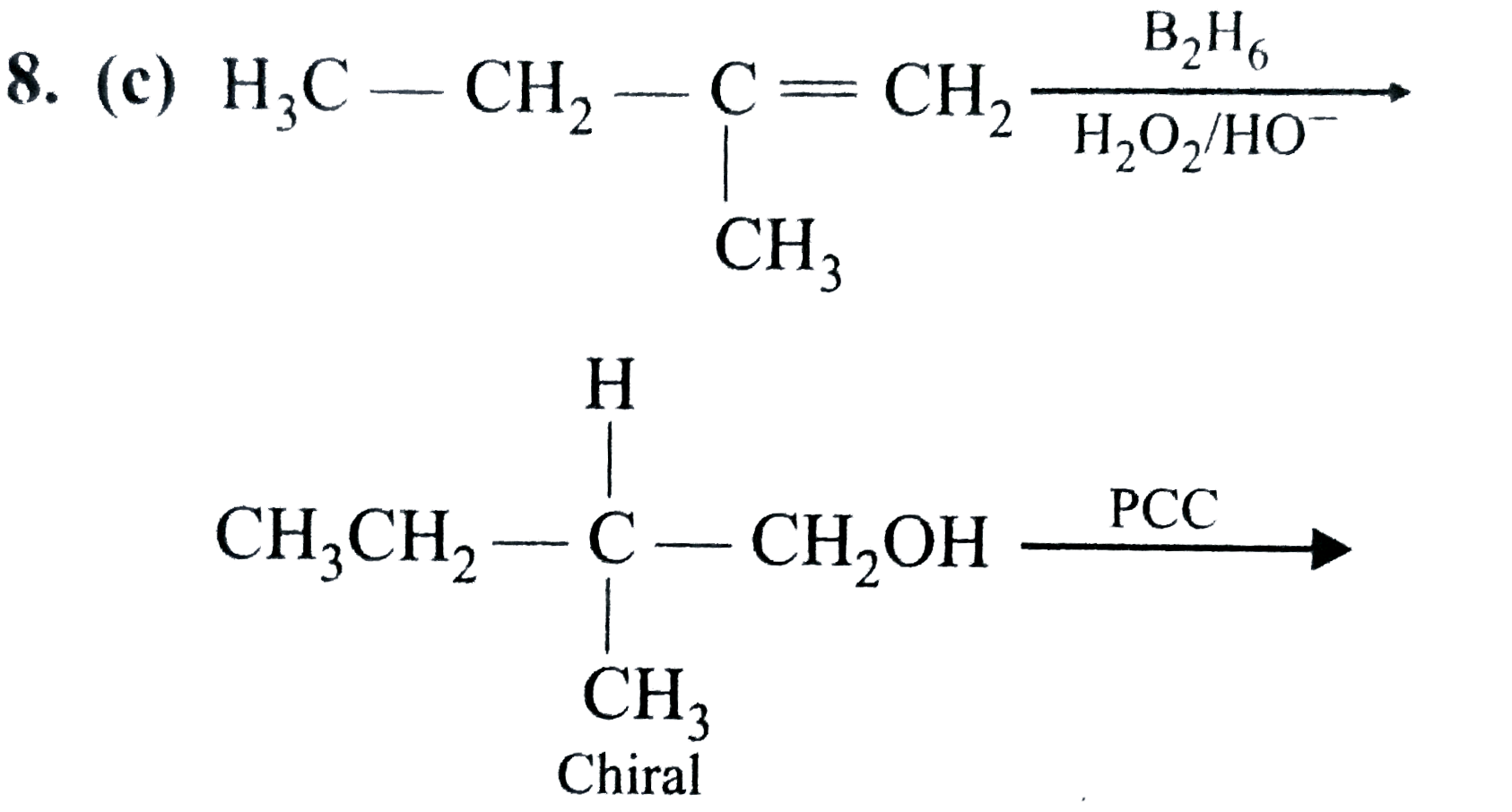A hydrocarbon X has molecular formula C5H10. X on tratement with B2H6in H2O2/NaOH given an optically active C5H12O which on tratment with CrO3/HCL/pyridine gives C5H10O which is still chiral. Which of the following can be a produce of reductive ozonolysis of X?
CH3−CH2−O∣∣C−CH3
CH3−O∣∣C−CH3
CH3−CH3∣CH−CHO

The correct Answer is:C
The following reaction are
Topper's Solved these Questions
- BOOK - A2ZCHAPTER - ALDEHYDES, KETONES AND CARBOXYLIC ACIDEXERCISE - Oxidation And Reduction Of Carbonyl Compounds54videos
ALDEHYDES, KETONES AND CARBOXYLIC ACID
- BOOK - A2ZCHAPTER - ALDEHYDES, KETONES AND CARBOXYLIC ACIDEXERCISE - Cannizaro'S Reaction15videos
ALDEHYDES, KETONES AND CARBOXYLIC ACID
- BOOK - A2ZCHAPTER - ALCOHOLS, PHENOLS AND ETHERSEXERCISE - Section D - Chapter End Test30videos
ALCOHOLS, PHENOLS AND ETHERS
- BOOK - A2ZCHAPTER - BIOMOLECULESEXERCISE - Section D - Chapter End Test30videos
BIOMOLECULES
Similar Questions
Knowledge Check
- Question 1 - Select One
The formula C5H10O represents
Aan aldehyde and a symmetrical ketone onlyBan aldehyde and an unsymmetrical ketone onlyCa symmetrical and an unsymmetrical ketone onlyDan aldehyde and a symmetrical as well as unsymmetrical ketone. - Question 2 - Select One
Compound having molecular formula C3H6O2 is:-
AC2H5−COOHBHCOOC2H5CCH3COCH3DBoth (a) and (b) - Question 3 - Select One
An optically active hydrocarbon X has molecular formula C6H12. X on catalytic hydrogenation gives optically inactive C6H14.X could be
A3− methyl−1−penteneB3−methl−2−penteneC4−methl−2−penteneD2−ethyl −1−butene
How many carboxylic acids are possible for molecular formula C5H10O2 ?
View SolutionCompound 'X' with the molecular formula C3H8O on vigronous oxidationy yields an acid C3H6O2.
View Solution4 A neutral, resolvable organic compound A has molecular formula (C8H16O2). A on treatment with LiAlH4 gives isomeric B and C(C4H10O) of which only B is optically active. B on treatment with acidified dichromate solution gives D(C4H8O), which on refluxing with dilute NaOH followed by acidification of product gave E(C8H14O). E on heating with N2H4 in alkaline medium affords F(C8H16) which on treatment with B.H/H,O,/HO produced a resolvable G (C8H18O). G on treatment with acidified dichromate solution produced H(C8H16O), which on treatment with MCPBA produces A.
Compound (H) isView Solution4 A neutral, resolvable organic compound A has molecular formula (C8H16O2). A on treatment with LiAlH4 gives isomeric B and C(C4H10O) of which only B is optically active. B on treatment with acidified dichromate solution gives D(C4H8O), which on refluxing with dilute NaOH followed by acidification of product gave E(C8H14O). E on heating with N2H4 in alkaline medium affords F(C8H16) which on treatment with B.H/H,O,/HO produced a resolvable G (C8H18O). G on treatment with acidified dichromate solution produced H(C8H16O), which on treatment with MCPBA produces A.
Compound (B) isView Solution4 A neutral, resolvable organic compound A has molecular formula (C8H16O2). A on treatment with LiAlH4 gives isomeric B and C(C4H10O) of which only B is optically active. B on treatment with acidified dichromate solution gives D(C4H8O), which on refluxing with dilute NaOH followed by acidification of product gave E(C8H14O). E on heating with N2H4 in alkaline medium affords F(C8H16) which on treatment with B.H/H,O,/HO produced a resolvable G (C8H18O). G on treatment with acidified dichromate solution produced H(C8H16O), which on treatment with MCPBA produces A.
Compound (E)View Solution

